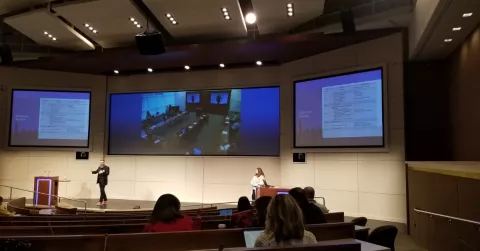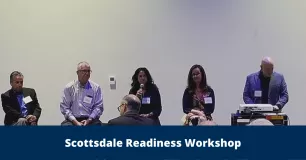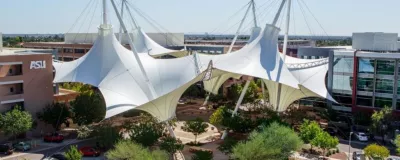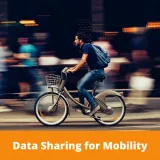
Three primary points of this Readiness Program update -
- North Carolina's Research Triangle is accelerating its intelligent mobility programs.
- A predicate to an intelligent mobility platform is the sharing of data.
- Intelligent mobility will be accelerated by (i) recruiting 'all' stakeholders, (ii) accurately scoping solutions and (iii) capturing information in a sustainable manner
Your Participation: if you seek to participate in 2022 in our Readiness Program -
- What - Readiness Workshop on December 9, 2021 with North Carolina Research Triangle. See RECAP for a specific summary of topics, use cases and solutions reviewed.
- Where - SAS Institute HQ in Cary, NC
- Who (see specific list at RECAP link) There were participants from Wake County, Raleigh along with towns of Apex, Cary, Morrisville and Wilson NC, Triangle J Council of Governments, NC Dept of Transportation, Capital Metropolitan Planning Organization, Capital Area MPO (CAMPO,) Durham-Chapel Hill-Carrboro MPO (DCHC) AND Smart Cities Council Partners.
- Why - Accelerate Wake County’s development of an Integrated Mobility Platform with data sharing.
Our Goal of Accelerating Data Sharing for Wake County
On December 9 2021, the Smart Cities Council (‘Council’) convened a hybrid workshop at SAS Institute’s HQ in Cary NC to continue its work in assisting North Carolina’s Research Triangle accelerate the development of an Integrated Mobility Platform (‘IMP.’) Sponsored by Bridgestone Americas, SAS and RiOT, the workshop had over sixty (60) participants from local government and Council Partners.
While the goal is an Integrated Mobility Platform, the first step was to activate a data-sharing framework. Our goal in this workshop was to -
- Review all the information we had collected to date (See ReCap.)
- Identify existing needs
- Start identifying possible solutions.
"Integrated mobility platforms” allow cities to gather data from connected vehicle and infrastructure about prices, schedules, and real-time conditions.” McKinsey&Company – ‘Future of Mobility & How Cities Can Benefit’ (2017.)
Readiness Challenge Grant
Morrisville, NC applied to the Smart Cities Council for a grant to accelerate the reduction of traffic congestion in Wake County, NC. Morrisville applied in early 2021 and after a thorough review of its plans, was declared a Readiness Challenge Winner in the summer of 2021. Morrisville had sought assistance as the number one complaint of its residents was ‘traffic congestion’ and data showed that Morrisville and other residents in the Raleigh metropolitan region drive more miles in their cars in any other metropolitan region in the US.
Accelerating a project involves several key steps -
- Recruitment of stakeholders - the hardest task in starting any project is to identify and recruit the key stakeholders. Failure to identify these stakeholders early in the process often leads to a series of ‘starts and stops’ as new parties and their respective goals are introduced to a project plan. So, a clear requirement in accelerating the reduction in traffic congestion in Wake County is to make sure we have the right parties at the table.
- Scoping of solutions - there is a clear priority here to reduce traffic congestion. The question is which solution will do this ‘and’ meet agreed goals (return on investment and meeting key metrics?) Often agreeing to one priority can lead to dropping or delaying others. Given that the region was actively building and maintain roads, there was agreement that a technology and data solution such as an Integrated Mobility Platform needed to stay ‘top of mind’ and this Readiness Challenge grant could do that.
- Capturing information - a clear problem before you begin a project is capturing all the relevant information about needs, parameters (such as time and budget,) stakeholders and solutions in a usable framework. Using stickies, spreadsheets and presentations has limited uses (to put it mildly) and that is where the Council’s Smart Cities Activator online platform provides an innovative approach. You can see more information about Activator here.
The Council worked with Morrisville in recruiting other jurisdictions in the region. Once this was done, the parties needed to share information and then start analyzing facts to determine the scope of any solutions.
See the RECAP for demographic and other information about Wake County and its five cities.
Wake County Needs an Integrated Mobility Platform
Wake County is very ambitious about developing an Integrated Mobility Platform ('IMP.') It needs to be - as residents in the Raleigh North Carolina metro area (which includes Raleigh and the towns of Morrisville, Apex and Wilson) along with the Raleigh Durham Airport) spend more time in their cars than in any other metropolitan region in the US. See: 2020 Street Light Data Climate Impact Report.
As a point of reference, traffic congestion can cost North Carolina over $5.9B a year (1% of state GDP of $592B.) See: McKinsey&Company – ‘Future of Mobility & How Cities Can Benefit’ (2017.) Factors that can increase traffic congestion include -
- Population growth
- Vehicle number growth
- Unsatisfactory public transit
- Construction
- Business to home delivery
Advantageously, Wake County (NC Research Triangle) is a relatively wealthy region in the US. Density (residential and commercial housing) is low, which along with a disconnected public transit systems - leads to a lot of time in the car. So, it is described as a high-income, low-density region. In its Future of Mobility report identified above, McKinsey&Company identified an Integrated Mobility Platform as ideal for any high-income, low-density region because it can reduce traffic congestion and incidents significantly.

Defining Key Terms - Mobility versus Transportation
- In the same report, McKinsey&Company defines an Integrated Mobility Platform as "...allowing cities to gather data from connected vehicles and infrastructure about prices, schedules, and real-time conditions. Cities could use the data to make smarter improvements and give riders the ability to plan and pay for trips, even using multiple providers."
- As a point of reference, the most commonly used term Intelligent Transportation System which the US Dept of Transportation describes as "ITS improves transportation by integrating advanced information and communications-based technologies (ICT) into transportation infrastructure and vehicles. ITS refers to a system of technologies and operational advancements that, when combined and managed, improve the capabilities of the overall transportation system.
As used by these two organizations, the terms are very similar - but at the Council the key term going into the future is 'mobility' which we think more fully addresses the needs and opportunities of city residents as opposed to 'transportation' which describes the mode of movement. You can find a good discussion of the differences here.
Current Planning Includes Capacity Improvement and Automated Traffic Signaling
As detailed in the RECAP, the region has already started many road-building projects; but data shows that roads become congested within seven (7) years of being first used. So along with the adverse impact of working on roads during the construction term, the benefit can be transitory.
The region, led by the two MPO(s) recently developed a Regional ITS Strategic Deployment Plan (as an update to the region’s original 2009 plan.) One outcome of that process was the creation of a Regional ITS Working Group. The group recently held its initial kickoff meeting in October 2021, and plans to meet on a regular ongoing basis – representatives from TJCOG, MPOs, NCDOT, and local government.
The Regional ITS Strategic Deployment Plan has identified the predicate to an IMP, automated traffic signaling (‘ATS’) as a necessary first step. TJCOG’s plans identify developing a data-sharing framework within the region for automated traffic signaling, followed by the subsequent development of the automated traffic signaling.
When Morrisville applied to the Council for the Readiness Grant, we identified accelerating of a data sharing framework as a predicate first step to an ATS and eventually IMP. If the Council could assist Morrisville and Wake County in accelerating a data sharing framework, the developing of an automated traffic signaling capacity and Integrated Mobility Platform could also be accelerated.
Fortunately, the region had experience with data-sharing as in 2016 they had collaborated in sharing water-flow data for the purpose of predicting and mitigating damage caused by flooding. In fact, Cary had won an IDC award for this program.
RECAP - Go here to review the previous webinars the Council convened (video and presentations) for this program AND a summary of topics covered at the December 9 Readiness Workshop, along with a list of attendees.


